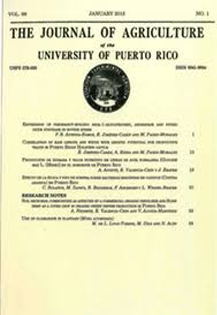Abstract
Transmission dynamics of viruses within and among cultivated plant species are often well known. Much less studied, especially in the tropics, is the dynamic of virus exchange between cultivated and nearby wild or weedy species, even though such exchanges are known to occur. To develop the best strategies for crop protection and general disease control, spatial distribution of viruses in non-cultivated plants needs to be understood. This research focuses on the potyviruses that infect Momordica charantia (Cucurbitaceae), an alien naturalized invasive vine in Puerto Rico. A total of 390 symptomatic and asymptomatic plants were sampled throughout Puerto Rico, including adjacent islands of Culebra and Vieques. Samples were subjected to an enzyme linked immunosorbent assay (ELISA) for general potyvirus screening, and to ELISAs specific for Papaya ringspot virus (PRSV) and Zucchini yellow mosaic virus (ZYMV). The species distribution model algorithm MaxEnt was used to predict suitable environments for the potential presence of potyvirus symptoms, potyvirus, PRSV or ZYMV in M. charantia. Almost half of the samples of M. charantia tested positive for ZYMV, PRSV or both viruses. Twice as many samples were positive for PRSV (39%) than for ZYMV (21%). About 14% of samples were positive for both potyviruses. Plants that tested positive for PRSV were three times more likely to be positive for ZYMV than were plants that were negative for PRSV. Plants that tested positive using the general potyvirus ELISA were much more likely to exhibit symptoms than plants testing negative for potyvirus. In comparison, PRSV and ZYMV samples testing positive or negative were equally likely to exhibit virus-like symptoms. When we classified samples according to habitat (agricultural, rural-nonagricultural, or urban), the presence/absence of symptoms and test results for potyvirus, PRSV and ZYMV were not dependent on habitat classification. By contrast, a MaxEnt model using 20 environmental variables was able to predict areas of Puerto Rico where environmental conditions are favorable for the potential presence of virus symptoms, potyvirus, PRSV or ZYMV in M. charantia. Conditions predicted by our model to be moderately to strongly suitable for the presence of PRSV in M. charantia covered a much larger area of Puerto Rico than they did for ZYMV. The vegetable growing region in the central to eastern south coast was predicted to have highly suitable environmental conditions for the presence of both potyviruses in M. charantia.

